The Life &
Career
of Leonard Rossiter
The Frontiers of
Farce:
The Purging; The Singer
The Purging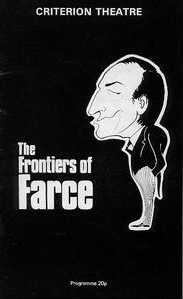
Written by Georges
Feydeau
The Singer
Written by Frank
Wedekind
Both plays Adapted and
Directed
by Peter Barnes
First Performances:
Old Vic. Theatre, London
- Monday 11th October, 1976
Criterion Theatre, London
- Tuesday 8th February, 1977
farce, n. 1.
a)
a coarsely comic dramatic work based on ludicrously improbable events.
b) this branch of
drama.
2. absurdly futile proceedings; pretence, mockery.
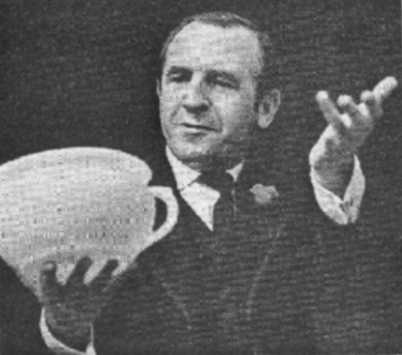 By
1976,
Leonard Rossiter had become a household name with television viewers,
thanks
to his unforgettable portrayal of the lecherous landlord Rigsby in
YTV's
Rising Damp. He was about to add another character to television
legend,
too - Reginald Perrin. Despite this, Leonard's roots always belonged in
the theatre, and 1976 saw him return to the stage in two one-act plays
by two of the world's greatest farceurs. As with many of Leonard's
roles,
the characters he played seemed to have been "made for him"; he
delighted
theatre-goers with his performance in the shows during 1976 and 1977,
and
Leonard once again amazed his co-stars and directors by having
memorized
both plays after just three days of a planned four-week rehearsal.
By
1976,
Leonard Rossiter had become a household name with television viewers,
thanks
to his unforgettable portrayal of the lecherous landlord Rigsby in
YTV's
Rising Damp. He was about to add another character to television
legend,
too - Reginald Perrin. Despite this, Leonard's roots always belonged in
the theatre, and 1976 saw him return to the stage in two one-act plays
by two of the world's greatest farceurs. As with many of Leonard's
roles,
the characters he played seemed to have been "made for him"; he
delighted
theatre-goers with his performance in the shows during 1976 and 1977,
and
Leonard once again amazed his co-stars and directors by having
memorized
both plays after just three days of a planned four-week rehearsal.
By its
very nature, farce commands an intense outpouring of energy, impeccable
timing and a total immersion of the actor into his role - something
Leonard
had been doing for twenty years or more. Originally to be found in
aspects
of theatre including clowning, acrobatics and indecency, farce soon
grew
into a style of dramatic comedy all its own, and the two playwrights
whose
works were performed by Leonard were instrumental in its increased
popularity.
With the advent of cinema in the early twentieth century, farce was one
its most popular genres, with Charlie Chaplin, the Keystone Kops and
the
Marx Brothers helping to bring it off the stage and onto the silver
screen.
Indeed,
when the French film director Jean Renoir (son of the great painter
Auguste)
decided to experiment with cinematography, he chose one of the two
plays
described here - The Purging, releasing it in 1931 under its
original
French title On
Purge Bebe. Written in 1910, one of four one-act pieces, The
Purging
is second only to A Flea In Her Ear as Feydeau's most-performed play.
The
story, set in Paris in 1904, concerned an inventor, Follovoine, who had
developed what he believed to be an indestructable chamber pot, a
desired
- or so he thought - requirement for the French Army, to whom he
promptly
tried to sell them. It was written during Feydeau's separation from his
wife in 1909, and just before their divorce shortly afterwards. As
director
Peter Barnes described it, the play was "a farcical illustration of the
bleak dictum that husbands and wives are separated by nothing but
marriage".
Born in Paris on December 8th 1862, Georges Leon Jules Marie Feydeau
was
the son of a famous novelist (Ernest Feydeau, author of Fanny 1858). He
wrote more than sixty farces, none of which achieved great acclaim
during
his lifetime - only since the mid twentieth century has his work been
seen
as classic satire and as a cornerstone of modern farce. His plays often
took on the subjects of sexual immorality (for example unfaithful
spouses,
amorous escapades) as well as foreigners, the aged and the poor. They
were
also notable for their elaborate stage settings and improbable plots,
often
involving mistaken identity. (This was not Leonard's first performance
of a work by Feydeau. He had a bit-part in the 1966 film Hotel
Paradiso, adapted from Feydeau's play Hotel du Libre Echange).
Georges
Feydeau died in Paris on June 5th 1921.
The
second
play,
The Singer, was set in a Berlin hotel in 1898. Originally
titled The Court Singer (as translated from the German Der
Kammersanger),
the play followed Dhuring, a mad composer, who had written an opera for
a popular tenor and was determined to make him hear it and perform it.
Written in 1899 at the height of Wagner-mania in Europe, the play aims
to expose the reality behind the pretensions of 'high culture'. Its
author,
Benjamin Franklin Wedekind was a major forerunner of the Theatre of The
Absurd (under whose umbrella come such great playwrights as Samuel
Beckett
and Harold Pinter); his dramas employed episodic scenes,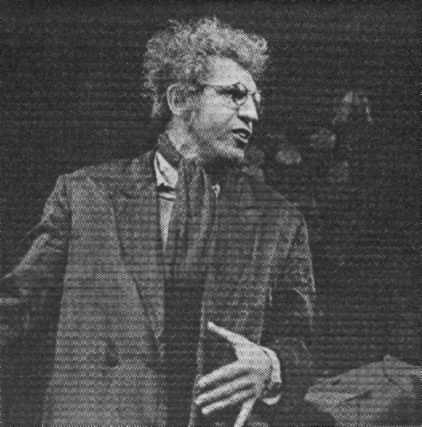 fragmented dialogue
and caricature. A central theme in many of Wedekind's plays is the
publicizing
of society's antagonism toward the power of sex, a theme that led to
him
being called "the prophet of sexuality in modern drama". Wedekind's
life
was rich and varied. Born on July 24th 1864 in Hanover to a
German-American
father and Swiss opera singer mother, he wrote plays in his spare time,
while being variously employed as a journalist, an advertising manager,
a cabaret performer and even a secretary for a circus! When a success
as
a dramatist he acted in and produced many of them himself. Some of his
works - notably those concerning puberty and sexual awakening, such as
The Awakening of Spring in 1891 and Pandora's Box, 1904 - caused a
public
scandal at the time, but are now the foundations of expressionism in
the
theatre. Frank Wedekind died in Munich on March 9th, 1918.
fragmented dialogue
and caricature. A central theme in many of Wedekind's plays is the
publicizing
of society's antagonism toward the power of sex, a theme that led to
him
being called "the prophet of sexuality in modern drama". Wedekind's
life
was rich and varied. Born on July 24th 1864 in Hanover to a
German-American
father and Swiss opera singer mother, he wrote plays in his spare time,
while being variously employed as a journalist, an advertising manager,
a cabaret performer and even a secretary for a circus! When a success
as
a dramatist he acted in and produced many of them himself. Some of his
works - notably those concerning puberty and sexual awakening, such as
The Awakening of Spring in 1891 and Pandora's Box, 1904 - caused a
public
scandal at the time, but are now the foundations of expressionism in
the
theatre. Frank Wedekind died in Munich on March 9th, 1918.
Leonard's Role
Remembered:
"In The Purging, there was
the sheer joy of listening to Leonard describing Follovoine's chamber
pot
as if it were an objet d'art...Follovoine, demonstrating the
indestructibility
of his chamber pot, broke it. He then went on to break - as only
Leonard
could break - one after another, fourteen pots in all...Leonard and
Feydeau
were hilarious." - Robert Tanitch.
"Leonard Rossiter was the
best farceur of his generation, because the most serious. On stage he
combined
incredible speed with absolute physical and verbal precision. I once
asked
him to slow down during rehearsals so we could concentrate on certain
details.
But he said that he was only able to think comedically at high speed...
He was disturbingly word-perfect in two large parts after just three
days
of a planned four-week rehearsal... His energy and concentration were
prodigious.
He always had to change shirts at least once during
rehearsals."
"In the role of the mad composer... he wore a hideous set of protruding
false teeth. In the middle of a preview performance they shot out of
his
mouth and into a wastepaper basket. Still in character and mouthing
dialogue,
though now apparently toothless, he retrieved the teeth, turned to the
audience, shrugged and said: 'What do you expect? This is a
preview!'."
- Peter Barnes, director.
"...But it was in the
black
farce by Wedekind, The Singer, that Len gave one of the finest comic
performances
I have ever seen... He didn't ask for a laugh. Never conspired with the
audience. The laughs came, thick and fast, because he was totally
inside
the character, driven by his enormous energy, usually wanted something
bigger and better than mere laughs. He was a great comic
actor."
"Len had evolved for himself an extraordinary get-up. A long, yellow
oilskin
garment down to the floor, a black felt hat, enormous false teeth,
pince-nez...
Yet Len never went over the top because he gave these things life. His
commitment to the idea was total." - John Phillips, co-star, The Singer.
"...I loved his
performance
so much I used to step down-stage, back to the audience, and just enjoy
it." - John Stride, co-star, The Singer.
Critical Reviews:
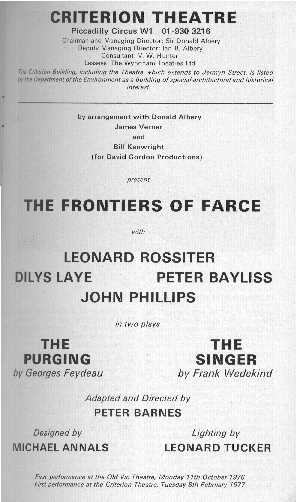
"The lunatic frenzy
sustained
by Mr. Rossiter in his scene - some twenty minutes with hardly a breath
drawn - is a delight and a wonder to behold, but the nervous energy in
it is alarming; I hardly dare to wish the enterprise well, for with
seven
such performances a week Mr. Rossiter will be dead before Christmas." -
Bernard Levin, Sunday Times.
Picture: A
cartoon
by John Jenson which appeared in Punch. The left half portrays
Leonard,
sweating profusely, as Follovoine in The Purging, with John Phillips.
The
right half shows John Stride with Leonard as the mad composer Dhuring
in
The Singer.
Return
to Theatre Performances - 1970s/80s
Return
To Index Page
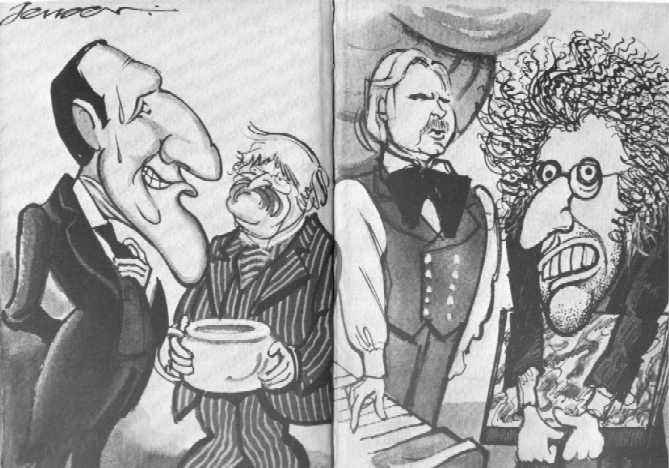
Text (c) Paul Fisher
Pictures (c) their
respective
owners
 By
1976,
Leonard Rossiter had become a household name with television viewers,
thanks
to his unforgettable portrayal of the lecherous landlord Rigsby in
YTV's
Rising Damp. He was about to add another character to television
legend,
too - Reginald Perrin. Despite this, Leonard's roots always belonged in
the theatre, and 1976 saw him return to the stage in two one-act plays
by two of the world's greatest farceurs. As with many of Leonard's
roles,
the characters he played seemed to have been "made for him"; he
delighted
theatre-goers with his performance in the shows during 1976 and 1977,
and
Leonard once again amazed his co-stars and directors by having
memorized
both plays after just three days of a planned four-week rehearsal.
By
1976,
Leonard Rossiter had become a household name with television viewers,
thanks
to his unforgettable portrayal of the lecherous landlord Rigsby in
YTV's
Rising Damp. He was about to add another character to television
legend,
too - Reginald Perrin. Despite this, Leonard's roots always belonged in
the theatre, and 1976 saw him return to the stage in two one-act plays
by two of the world's greatest farceurs. As with many of Leonard's
roles,
the characters he played seemed to have been "made for him"; he
delighted
theatre-goers with his performance in the shows during 1976 and 1977,
and
Leonard once again amazed his co-stars and directors by having
memorized
both plays after just three days of a planned four-week rehearsal.

 fragmented dialogue
and caricature. A central theme in many of Wedekind's plays is the
publicizing
of society's antagonism toward the power of sex, a theme that led to
him
being called "the prophet of sexuality in modern drama". Wedekind's
life
was rich and varied. Born on July 24th 1864 in Hanover to a
German-American
father and Swiss opera singer mother, he wrote plays in his spare time,
while being variously employed as a journalist, an advertising manager,
a cabaret performer and even a secretary for a circus! When a success
as
a dramatist he acted in and produced many of them himself. Some of his
works - notably those concerning puberty and sexual awakening, such as
The Awakening of Spring in 1891 and Pandora's Box, 1904 - caused a
public
scandal at the time, but are now the foundations of expressionism in
the
theatre. Frank Wedekind died in Munich on March 9th, 1918.
fragmented dialogue
and caricature. A central theme in many of Wedekind's plays is the
publicizing
of society's antagonism toward the power of sex, a theme that led to
him
being called "the prophet of sexuality in modern drama". Wedekind's
life
was rich and varied. Born on July 24th 1864 in Hanover to a
German-American
father and Swiss opera singer mother, he wrote plays in his spare time,
while being variously employed as a journalist, an advertising manager,
a cabaret performer and even a secretary for a circus! When a success
as
a dramatist he acted in and produced many of them himself. Some of his
works - notably those concerning puberty and sexual awakening, such as
The Awakening of Spring in 1891 and Pandora's Box, 1904 - caused a
public
scandal at the time, but are now the foundations of expressionism in
the
theatre. Frank Wedekind died in Munich on March 9th, 1918.

